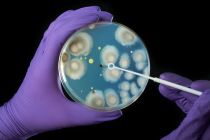Hydroponics and Beneficial Microorganisms
Hydroponics and Beneficial Microorganisms
By Clifford Woods
 Hydroponics is a subtype of hydro-culture or growing plants in water with nutrient solutions. It is a soil-less way of planting. Hydroponics derived its name from the Greek word “hydro” or water and “ponos” meaning labor.
Hydroponics is a subtype of hydro-culture or growing plants in water with nutrient solutions. It is a soil-less way of planting. Hydroponics derived its name from the Greek word “hydro” or water and “ponos” meaning labor.
William Frederick Gericke of the University of California at Berkeley was one of the first ones to cultivate plants on mineral nutrient solutions. Gericke coined the term hydroponics in 1937 (although he asserts that the term was suggested by W. A. Setchell, of the University of California).
Through these types of studies, it was discovered that plants could thrive not only in soil, but also in water, since water contains the essential nutrients and beneficial microorganisms that are also present in the soil.
Hydroponics turned out to be more advantageous than soil culture, because pests are easy to control in this type of system. In natural conditions, soil acts as a mineral nutrient reservoir but the soil itself is not essential to plant growth. When the mineral nutrients in the soil dissolve in water, plant roots are able to absorb them.
When the required mineral nutrients are introduced into a plant’s water supply artificially, soil is no longer required for the plant to thrive. Almost any terrestrial plant will grow with hydroponics.
Since the water environment of the plant can be controlled, nutrient solutions can be incorporated into the water depending on the nutrient needs of the plant. Many hydroponics growers also incorporate beneficial microorganisms as supplements to nutrients in the water.
There is actually a full range of ways to benefit from beneficial microorganisms, which can be utilized in hydroponics. The secret is only to know when to apply and how much to apply. Here are some of the benefits of beneficial microorganisms.
Development of Seeds and Clones
Beneficial microorganism is not just used on the hydroponics systems itself, but also for propagating seeds and also on developing the cuttings. This stage of crucial development in plant life and beneficial bacteria will help boost the growth and development of these plants and cuttings. During this time, beneficial microorganism incorporation should be three times the normal use.
Elimination of Pathogens in the System
Harmful microorganisms that cause diseases increase even in the hydroponic systems during root development. These harmful microorganisms, which are also called pathogens, result to plant diseases or plant death. There are certain types of beneficial microorganism that kill these pathogens.
It is important to know what type of pathogen is attacking the system to know what type of beneficial microorganism to incorporate in the hydroponics system. Moreover, these also strengthen plants defences against harmful pathogens in a way like the immune system is boosted by supplements.
Boosts Nutrient Uptake of Hydroponics Plants
Most beneficial microorganism types boost the nutrient uptake of plants in the hydroponics system by keeping the roots healthy by strengthening roots and increasing root size, since it is the one responsible for absorption. When spraying leaves with foliar fertilizer, these microorganisms may also be incorporated in the solution to enable the stomata of the leaves to absorb better.
Makes the Environment Suitable for Plant Growth
Beneficial microorganisms control the environment such as correcting the atmospheric nitrogen and producing nitrogen for plants, since plants cannot produce their own. Some fungi types also help in assimilating phosphorous when incorporated in the hydroponics system.
Hydroponics is a new way in cultivating plants where the environment can be controlled to eliminate any usual problems experienced from soil gardening. The strategy is to provide an environment that plants can thrive on and this is through providing the correct amount of nutrients supplemented with incorporating beneficial microorganisms.
***
 Clifford Woods is the CEO of Effective Environmental Services and Organic Environmental Technology
Clifford Woods is the CEO of Effective Environmental Services and Organic Environmental Technology
We brew Beneficial Microorganisms that eat toxins and offer Natural Organic Solutions.














